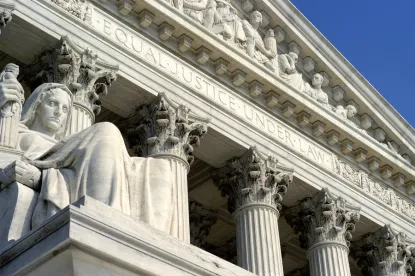On April 20, 2020, the Supreme Court held in a 6-3 decision that the Sixth Amendment requires a unanimous jury verdict to convict a defendant of a serious offense in state courts. In so holding, the Court not only paved the way for potentially hundreds of defendants convicted by divided juries, like petitioner Evangelisto Ramos, to obtain new trials, but also effectively overturned its prior holding in Apodaca v. Oregon. Thus, the potential impact of Ramos v. Louisiana extends far beyond issues of criminal procedure, as the justices’ spirited debate over when and whether to overturn precedent took center stage and illustrated deep divisions within the Court.
In 2016, a Louisiana jury found Ramos guilty of second-degree murder by a vote of 10-2. At the time of Ramos’s trial, Louisiana and Oregon were the only two states that did not require unanimous jury verdicts for serious criminal offenses. Just a few years later, Louisiana voters approved a constitutional amendment that eliminated non-unanimous jury verdicts. However, this amendment was not retroactive, and Ramos ultimately challenged his conviction by arguing that the Sixth Amendment, which establishes the right to an “impartial jury,” requires a unanimous jury verdict—including in state courts.
Siding with Ramos, the majority found that the Sixth Amendment’s unanimous jury requirement is incorporated against the states through the Fourteenth Amendment. Justice Neil Gorsuch wrote the majority opinion, which was joined in full by Justices Ruth Bader Ginsburg and Stephen Breyer and in part by Justices Sonia Sotomayor and Brett Kavanaugh. Justice Clarence Thomas agreed that the Sixth Amendment requires unanimous verdicts in state court criminal proceedings, but he disagreed with the majority’s reasoning; in a separate concurrence, he argued that this right applies to the states through the Privileges and Immunities Clause.
At the outset of the majority opinion, Justice Gorsuch explained that the Constitution’s text and structure clearly indicate that the Sixth Amendment term “trial by an impartial jury” includes the requirement that a jury must reach a unanimous verdict in order to convict—a fact he described as “unmistakable.” Justice Gorsuch also found it equally clear that the Sixth Amendment’s unanimous jury requirement “applies to state and federal criminal trials equally.”
How, then, were Louisiana and Oregon able to permit and enforce jury rules that did not require unanimous verdicts? The answer—and the biggest wrinkle in Justice Gorsuch’s straightforward framing of the issue in the case—is the Court’s 1972 decision in Apodaca v. Oregon.
Apodaca involved essentially the same question presented by Ramos: several defendants who had been convicted by less than unanimous verdicts argued that their constitutional rights had been violated, because the Sixth Amendment (made applicable to the states through the Fourteenth Amendment) required unanimity. The Apodaca justices were starkly divided: four justices found that the unanimity requirement applied to the states, while another set of four justices said that the Sixth Amendment imposed no unanimity requirement at all. Justice Lewis F. Powell served as the tiebreak, arguing that the unanimity requirement of the Sixth Amendment applied only to federal (but not state) prosecutions.
Whether Justice Powell’s reasoning served as the holding of Apodaca and created binding precedent deeply divided the Court in Ramos, and led to an intense debate over the doctrine of stare decisis—that is, the idea that courts are obligated to adhere to prior decisions in factually similar cases.
Justice Gorsuch, joined only by Justices Ginsburg and Breyer, argued that the Court did not need to overturn Apodaca because it did not serve as binding precedent. Essentially, he argued, to accept Justice Powell’s reasoning “as precedential, we would have to embrace a new and dubious proposition: that a single Justice writing only for himself has the authority to bind this Court to propositions it has already rejected.”
Even if Apodaca were binding precedent, Justice Gorsuch maintained that there is ample cause to overturn it. Not only were the jury laws in Oregon and Louisiana tainted by racial bias, as he outlined elsewhere in the opinion, “no one on the Court is prepared to say [Apodaca] was rightly decided, and stare decisis isn’t supposed to be the art of methodically ignoring what everyone knows to be true.” Although he acknowledged that the ruling would have an immediate impact on Oregon and Louisiana courts, Justice Gorsuch noted that changes to criminal procedure always cause some disruption—and usually, such changes impact “significant numbers of pending cases across the whole country,” rather than just in two states.
In a separate concurrence, Justice Sotomayor seemed to agree with Justice Gorsuch that Apodaca was not only wrongly decided, but an outlier—a “universe of one” that was at odds with the Court’s jurisprudence regarding the Sixth Amendment’s unanimity requirement and the applicability of the Bill of Rights to the states. Rather than rigidly adhering to stare decisis, she noted that “[w]here the State’s power to imprison those like Ramos rests on an erroneous interpretation of the jury-trial right, the Court should not hesitate to reconsider its precedents.” Justice Sotomayor further agreed with Justice Gorsuch that the racially biased history of these laws “is worthy of this Court’s attention.”
In a separate concurrence, Justice Kavanaugh further weighed in on the issue of stare decisis, noting that, in recent times, “every current Member of this Court has voted to overrule multiple constitutional precedents.” To create more uniformity, he proffered a three-factor test to be used by the Court in determining whether and when to overturn precedent: whether the decision is “grievously or egregiously wrong”; whether the decision has “significant negative jurisprudential or real-world consequences”; and whether “overruling the prior decision unduly upset[s] reliance interests.” After applying this three-part test, Justice Kavanaugh agreed that Apodaca was “egregiously wrong” and should be overturned.
Justice Samuel Alito was not persuaded. “The doctrine of stare decisis gets rough treatment in today’s decision,” he wrote at the outset of his scathing dissent, which was joined by Chief Justice John Roberts and, for the most part, Justice Elena Kagan. Justice Alito and his fellow dissenters were highly critical of Justice Gorsuch’s suggestion that Apodaca was not binding precedent, and accused the majority of “lowering the bar for overruling our precedents.”
Moreover, Justice Alito emphasized the reliance interests of the states in crafting these jury systems: “Understandably thinking that Apodaca was good law, the state courts in Louisiana and Oregon have tried thousands of cases under rules that permit such verdicts. But today, the Court does away with Apodaca and, in so doing, imposes a potentially crushing burden on the courts and criminal justice systems of those States.” He criticized the majority for “brush[ing] aside these consequences and even suggest[ing] that the States should have known better than to count on our decision.”
At first glance, the 6-3 vote in this case suggests that, on balance, the Court was aligned in reaching a decision in Ramos. But closer examination of each opinion shows a deeply divided Court. While the Ramos decision is significant for ending the decades-long debate over non-unanimous jury verdicts, its legacy will likely include the start of a new battle over how the Court handles precedent. As the Court continues to grapple with high-stakes issues, particularly those that could lead to overturning prior decisions, the justices’ clashing views over stare decisis will likely only intensify.



 />i
/>i

